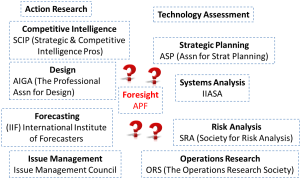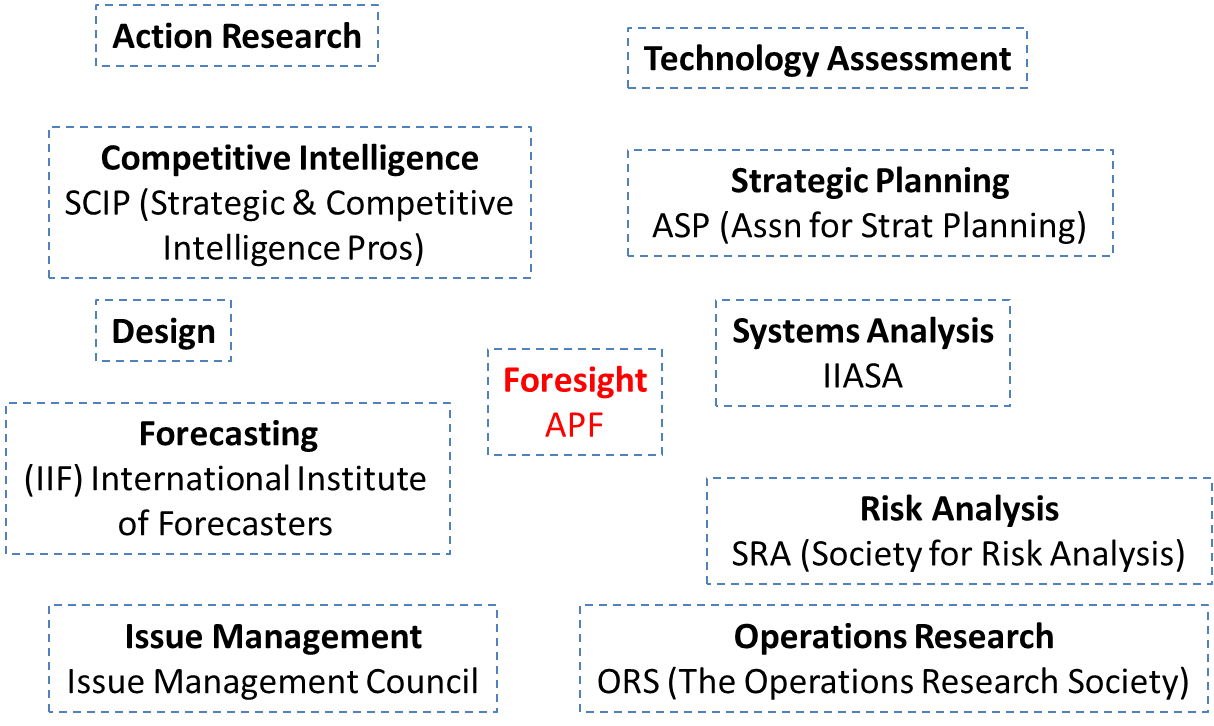The APF Professionalization Task Force has moved from planning to action and the first action is developing a competency model for foresight. It makes sense to begin with that task as it provides a foundation for subsequent planned efforts, such as building a professional development pathway and defining professional standards.
 Accompanying this task, we are “mapping the foresight ecosystem.” [A first draft of the map is to the right] We are looking at related fields, mapping out what they do, and comparing it to what we do. It will help us define who we are as we learn more about what is really unique about what futurists do. It’s a bit of a challenge since we are so multi-disciplinary, what exactly is “ours” and what do we share with others? The objective, then, is to map it out and compare. This will help us define our competencies – in the sense of being clear about what we find to be the core activities of futurists. This work also provided an opportunity for a couple of Houston Foresight students, Omeke Alikor and Jason Crabtree, to make a contribution to the field by doing supporting research.
Accompanying this task, we are “mapping the foresight ecosystem.” [A first draft of the map is to the right] We are looking at related fields, mapping out what they do, and comparing it to what we do. It will help us define who we are as we learn more about what is really unique about what futurists do. It’s a bit of a challenge since we are so multi-disciplinary, what exactly is “ours” and what do we share with others? The objective, then, is to map it out and compare. This will help us define our competencies – in the sense of being clear about what we find to be the core activities of futurists. This work also provided an opportunity for a couple of Houston Foresight students, Omeke Alikor and Jason Crabtree, to make a contribution to the field by doing supporting research.
Down the road, this map can help us explore how to work with related fields….alliances, mergers even(?), simple conference exchanges, etc.. We’re clarifying who we are to help us build our profession as well as finding out who wants to play with us, and how do they want to play. For my part, I’m more interested in learning who wants to be a part of foresight than in keeping people out (though, perhaps, there may need to be some of that). For example, do strategic planners or competitive intelligence folks or designers, etc. want to be part of the field? How might they want to associate with us (if at all)? It’s going to be interesting to find out. Lots more to come from this initiative – stay tuned. Andy Hines

Andy, what about “market research” as one of these related fields. This would encompass consumer behavior, trend analysis and industry research. Each of these is huge for business or market analysts, and it would seem futurists intersect with the outer limits of this practice.
While I am on a roll, what about the practice and discipline of leadership, that corresponds to your “visioning,” “planning,” and “acting” practices in your TATF framework? I am thinking of Burt Nanus, who has been involved in the World Future Society over the years.
Nanus, B. (1995). Visionary leadership: Creating a compelling sense of direction for your organization. The Jossey-Bass management series). San Francisco, CA: Jossey-Bass.
Other streams of leadership, such as transformational leadership, touch on this aspect of developing/cultivating vision, focus and direction for team or organization.
So “Leadership Studies” might also be considered a related field. The home of that is the International Leadership Association: http://www.ila-net.org/
They are very active in both scholarship and practice and have a good connection to master and doctoral programs.
Andy, one more might be Disruptive Innovation. Perhaps you captured some of that in Design, but there are entire communities of practice focused on Business Model Innovation and Entrepreneurship. I just picked up a great book called “Accelerators” by Deerling featuring who investors are now using incubators (not tied to location) to launch start-ups. While they deal mostly with on the horizon business, many do encapsulate a beyond the horizon paradigm, as Disruptors. In fact there is a growing community of practice around “Disruptive Innovation” spawned by Clayton Christensen’s work, applied to various industries.
All good suggestions, Jay. I supposed the reason they are not on their now (or yet) is that they don’t have an explicit focus on the future. As I write that, I could easily see an argument being made that they at least do so implicitly.